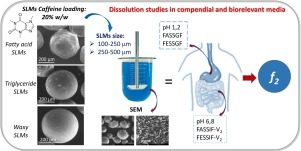An investigation into the release behavior of solid lipid microparticles in different simulated gastrointestinal fluids

In recent years there has been a growing interest in solid lipid-based systems, particularly in solid lipid microparticles (SLMs); however, only very few studies deeply investigated the dissolution behaviour of orally delivered-SLMs. The present study provides new insights about the release performance in different gastrointestinal fluids of SLMs containing a freely water soluble drug (caffeine, as BCS class I drug). Three different formulations of SLMs were prepared by spray congealing using lipid excipients belonging to three chemical classes: fatty acids, triglycerides and waxes. The dissolution profiles of caffeine were investigated using various updated biorelevant dissolution media simulating the conditions of the gastrointestinal tract (gastric tract and proximal human intestine). The profiles were statistically compared and the morphological changes of the particles after dissolution were assessed by SEM analysis. The influence of the SLMs composition resulted to be crucial on the dissolution behavior in the case of bigger particles (>250 μm), while smaller SLMs (100-250 μm) were mainly affected by the fluid composition. Moreover, regardless of the particle size, greater differences in drug release profiles were noted by using different intestinal media compared to those obtained in gastric media. In particular, the drug release from fatty acid and triglyceride-based SLMs was more controlled in the phosphate buffer than in the intestinal biorelevant media; while the opposite behavior was noticed for waxy-bases SLMs. Overall, the present study provides interesting insights which can be useful for the design of a multiparticulated solid lipid formulation.

